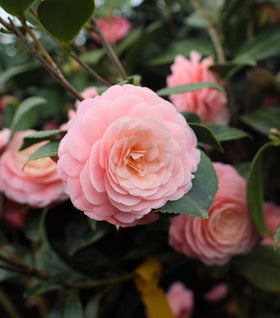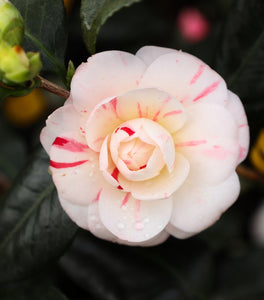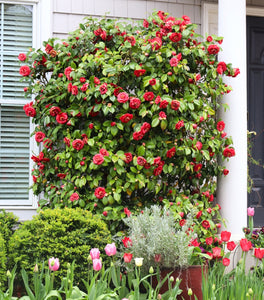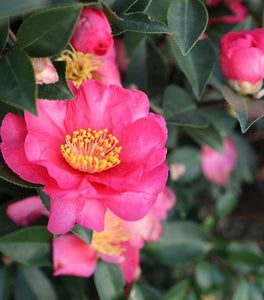Images Depict Mature Plants
Sadaharu Oh Camellia Shrubs for Sale Online
Camellia Sadaharu Oh Shrubs feature red flowers edged in white that blooms in the spring. With a semi-pendulous habit, this vigorous upright plant matures at 10 to 12 feet tall and 4 to 5 feet wide.
| Hardiness Zone: | 7-9 |
|---|---|
| Mature Height: | 10 to 12 feet |
| Mature Width: | 4 to 5 feet |
| Classification: | Broad Leaved evergreen shrub, Spring flowering |
| Sunlight: | Full Sun to Part Shade |
| Habit: | Evergreen, densely branched |
| Flower Color: | Red flowers edged in white |
| Foliage: | Dark green |
| Soil Condition: | Any well drained soil |
| Water Requirements: | Water well until established |
| Uses: | Extremely attractive when used as a focal point in the mixed border, mass planting, or a specimen planting. Provides unmatched winter interest due to its flowering in the late winter |
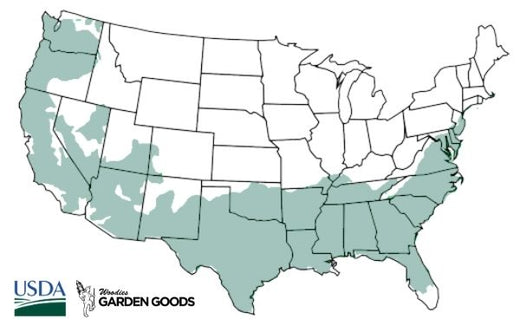
How to Care for Camellia Sadaharu Oh
Be sure to read our planting instructions to ensure a healthy and happy plant for years to come!
How do I plant Camellia Sadaharu Oh Shrubs in my garden?
We suggest when planting your newly purchased Camellia Sadaharu Oh Shrubs because more times than not these products will retain entirely to much moisture and will cause the root system to rot. Adding compost or topsoil will help the young feeder roots of Camellia Sadaharu Oh spread through the loose, nutrient-rich soil much easier than if you used solely the existing soil, which more times than not will be hard and compacted. The most common cause of plant death after transplanting is planting the new plant too deep. That is why we do not recommend planting in a hole any deeper than the soil line of the plant in the pot. A good rule is that you should still be able to see the soil the plant was grown in after back-filling the hole. Bio-tone starter fertilizer is a great starter fertilizer that provides plants with mycorrhizae fungus. It is a naturally-occurring, beneficial fungus that colonizes on the new growing roots of plants. It creates a barrier between the roots of the plant and fungus and pathogens that can cause root rot. We love this product and use it on all plants we install in our own gardens. Bio-tone is a gardener's best friend and can help guarantee your success.
Watering Camellia Sadaharu Oh Shrubs
After back filling and lightly compacting the 50/50 mix of existing soil and compost give the Camellia Sadaharu Oh a good, deep watering. This is not to be rushed. Most of the water you put on the plant at first will run away from the plant until the soil is soaked. A general rule of thumb is to count to 5 for every one gallon of pot size. For example, a one gallon pot would be watered until you count to 5; a three gallon pot would be 15; and so on. Check the plant daily for the first week or so and then every other day there after. Water using the counting method for the first few weeks.
A Short Course on Fertilizers
When looking at most fertilizers, they are described by three numbers on the bag. An example would be 10-10-10 or 12-4-8. The first of these three numbers refers to Nitrogen, which is the primary element necessary for good, balanced growth within the plant. Plants that are deficient in Nitrogen are usually not growing vigorously, and sometimes exhibit pale colored foliage. Not all Nitrogen deficiencies result in stunted growth. Sometimes, the growth is taller and longer with less than desirable branching when Nitrogen is deficient. The second number in the fertilizer equation is representative of Phosphorus. A deficiency of Phosphorus may affect the energy transfer in the plant, and result in stunted growth as well. Also, plants with insufficient amounts of Phosphorus may have poorer root systems. Potassium is the element represented by the third number on the fertilizer bag. Plants that are deficient in Potassium, are usually growing more slowly than normal, have fewer flowers and seed, and are more susceptible to disease than plants with adequate levels of Potassium. Although the three elements just mentioned are the major elements necessary for good plant performance, there some minor elements that are just as important in consideration of camellia nutrition. Minor elements that are not included in the three numbers listing on the front of fertilizer bags are very important considerations when choosing your plants fertilizer. Elements such as Magnesium, Sulfur, Calcium, Iron, Manganese, Copper, Zinc, Boron, and Molybdenum play very important roles in providing camellias will adequate nutrition. Many times, less expensive fertilizers are sold that contain only the major elements needed, but not the minor elements. Always be sure to look on the fertilizer label on the back of the bag to see exactly what is included in the fertilizer.




